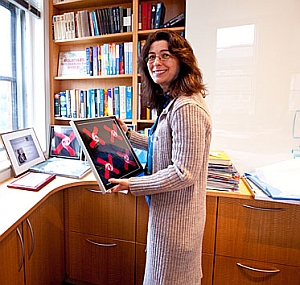Researchers at Harvard University tested a new liquid coating that prevents the accumulation of bacterial communities called biofilms from forming on surfaces. The team of engineers and materials scientists published its findings online in the journal Proceedings of the National Academy of Sciences.
Biofilms are collections of bacteria found on exposed surfaces in home, commercial, industrial, and health care settings. The bacterial colonies can cause infections in hospitals, food and water contamination, and decreased energy efficiency. Because of their persistence and widespread nature, biofilms are difficult, costly, and, in medical systems such as catheters or implants, frequently impossible to treat.
Lead author and materials scientist Joanna Aizenberg (pictured right), says biofilms have up to now resisted most surface treatments. “The surface treatments wear off, become covered with dirt, or the bacteria even deposit their own coatings on top of the coating intended to prevent them,” explains Aizenberg. “In the end, bacteria manage to settle and grow on just about any solid surface we can come up with.”
In their study, the Harvard team applied its recently developed slippery-liquid-infused porous surfaces or SLIPS technology to the problem. SLIPS creates an immobilized liquid layer on surfaces. In previous research, SLIPS showed it could repel both water- and oil-based liquids and even prevent ice or frost from forming.
In their paper, Aizenberg and colleagues report that over a seven-day period, SLIPS reduced almost entirely — 96 to 99 percent — the formation of three disease-causing biofilms: Pseudomonas aeruginosa, Escherichia coli (E. coli), and Staphylococcus aureus. “By creating a liquid-infused structured surface,” says co-author Alexander Epstein, “we deprive bacteria of the static interface they need to get a grip and grow together into biofilms.” Co-author Tak-Sing Wong adds, “In essence, we turned a once bacteria-friendly solid surface into a liquid one.”
The paper notes the technology works in static and flow environments, making it suitable for coating implanted medical devices that interact with bodily fluids. SLIPS-coated surfaces can also reduce bacterial growth in extreme environments, such as high pH levels, intense ultraviolet light, and high salinity.
The researchers plan to continue their study of SLIPS to better understand the way it interacts wth biofilm bacteria. In particular, they want to discover if bacteria transiently attach to surfaces and then slip off, just float above the surface, or if any individual bacteria can remain loosely attached.
Read more:
- Selenium Found to Control Staph Bacteria on Implant Material
- Nanotech Composites Aid Tooth Cavity Repair
- New Process Being Developed to Keep Berries Fresh Longer
- New Process Discovered for Fighting Contact Lens Bacteria
* * *


 RSS - Posts
RSS - Posts
[…] Liquid Coating Prevents Biofilm Build-Up on Surfaces […]